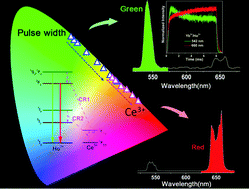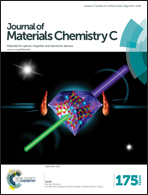Dual-mode modulation of luminescence chromaticity in AgLa(MoO4)2:Yb3+,Ho3+ up-conversion phosphors
Abstract
A series of Yb3+/Ho3+ co-doped and Yb3+/Ho3+/Ce3+ tri-doped AgLa(MoO4)2 phosphors with green (542 nm) and red (660 nm) double color up-conversion (UC) emissions with 980 nm near-infrared (NIR) excitation were synthesized by a sol–gel process. The UC emission color of the Yb3+/Ho3+ co-doped sample was tuned by adjusting the pulse width of an infrared laser from 0.2 to 10 ms and the introduction of Ce3+ by two methods. The emission color changed from pure green to yellow with the increase of pulse width, and the ratio of red to green emission (R/G) intensity was enhanced and single band red emission was obtained with a content of Ce3+ up to 10 mol%. The mechanism of chromaticity modulation by adjusting pulse width is attributed to the faster population rate of the green emission states than that of the red one which is related to two non-radiative relaxation (NR) processes. The fluorescence lifetime measurements show that the enhancement of the R/G ratio by Ce3+ doping results from two cross relaxation (CR) between Ho3+ and Ce3+. Furthermore, dynamic UC emissions from non-steady-state to steady-state were elaborated upon through transient time-dependent Ho3+ emission intensity in Yb3+/Ho3+ co-doped and Yb3+/Ho3+/Ce3+ tri-doped AgLa(MoO4)2. These results are helpful in controlling energy transfer of non-equilibrium UCL processes and realizing dynamic chromaticity modulation in rare earth doped luminescent materials.


 Please wait while we load your content...
Please wait while we load your content...